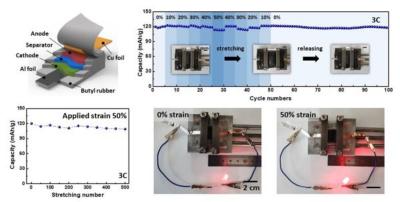Scientists in the Korea Institute of Science and Technology (KIST) have worked with graphene and carbon nanotubes to develop a working lithium-ion battery that can be stretched by up to 50% without damage to any of the components. According to the scientists, the battery represents a significant step in the development of wearable or body-implantable electronic devices.

Rather than trying to add inherently stretchable materials such as rubber to the battery components, the group focused on creating an accordion-like structure, adding stretchability to materials that are not inherently stretchable. Using graphene and carbon nanotubes, the scientists were able to construct a honeycomb-shaped composite framework, which was then compressed inwardly like an accordion to impart the stretchable properties.
The university notes that all of the materials within the battery are active in the battery, with the stretchable properties added as a bonus. Jeong Gon Son, who led the research at KIST, says that he expects the stretchable design to present a new paradigm in terms of stretchable energy storage systems for the further development of wearable and body-implantable electronic devices.



